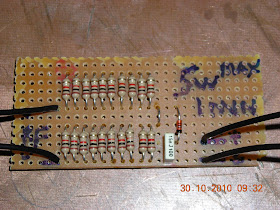
In Belgium and don't have the rest of the homebrew shack with me but needed a dummy load and ability to measure the RF levels so knocked this one together.




I found this article in the Lloyds Dipsy Dumpster - site, where you can find a lot of rare vintage radio articles, manuals and data sheets.
It is remarkable, that "Pilot Radio & Tube Corporation", well known as a manufacturer of the great Super-Wasp receivers, was a publisher of a Ham-Radio literature, handbooks and magazines, as well as many of early radio manufacturing companies. As for me, I like that sort of advertising much more, than modern spam in my mailbox and if it would be possible, it should be a nice choice to make this QRP transmitter using a native Pilot's parts only.
Anyway, when I've read this article, one interesting fact has drawn my attention - I can recognize the TNT when I see a TNT design, but in the text this transmitter has been described as a TPTG.. Moreover, there is a grid capacitor on the assembles view, but with a opposite description below: "condenser is not needed". So, in the article we can see that mysterious moment, when as the chrysalis becomes the butterfly, TPTG transmitter was transformed into a trendy TNT.
 my local big box hardware store. Since starting on this project I've been making trip after trip to buy yet one more bunch of screws, a particular clamp, a spool of wire, a ..... the list goes on. For a project that started with a $7 set of fiberglass poles this one certainly is a great example of "the devil's in the details".
my local big box hardware store. Since starting on this project I've been making trip after trip to buy yet one more bunch of screws, a particular clamp, a spool of wire, a ..... the list goes on. For a project that started with a $7 set of fiberglass poles this one certainly is a great example of "the devil's in the details". Here's the design of a cable TV distribution amplifier (CATV). This cable TV distribution amplifier has 5 outlets. This amplifier boosts the TV cable signal with 18dB before the signal is split into 5. The design is based around a MAR-6 MMIC. This Integrated Circuit amplifies DC to 2GHz with about 18dB, uses only 15mA and costs around 4,5 Euro.
Here's the design of a cable TV distribution amplifier (CATV). This cable TV distribution amplifier has 5 outlets. This amplifier boosts the TV cable signal with 18dB before the signal is split into 5. The design is based around a MAR-6 MMIC. This Integrated Circuit amplifies DC to 2GHz with about 18dB, uses only 15mA and costs around 4,5 Euro.